Azes II
| Azes II | |
|---|---|
| Indo-Scythian king | |
 Azes II in armour, riding a horse, on one of his silver tetradrachms, minted in Gandhara. | |
| Reign | Indo-Scythians: perhaps 35–12 BC |
| Predecessor | Azilises |
| Successor | Zeionises/Kharahostes |
Azes II (reigned c. 35–12 BCE) may have been the last Scythian king in Gandhara, western Pakistan. However, due to new research by R. C. Senior, his actual existence is now seriously in doubt, and "his" coins, etc., are now thought to refer to those of Azes I.[1]
After the death of Azes II, the rule of the Indo-Scythians in northwestern India and Pakistan finally crumbled with the conquest of the Kushans, one of the five tribes of the Yuezhi who had lived in Bactria for more than a century, and who were then expanding into India to create a Kushan Empire. Soon after, the Parthians invaded from the west. Their leader Gondophares temporarily displaced the Kushans and founded the Parthian that was to last until the middle of the 1st century CE. The Kushans ultimately regained Mardan and Taxila c. 75 CE, where they were to prosper for several centuries.
The Bimaran casket
Azes II is also connected to the Bimaran casket, one of the earliest representations of the Buddha. The casket, probably Greek work, was used for the dedication of a stupa in Bamiran, near Jalalabad in Afghanistan, and placed inside the stupa with several coins of Azes II. This event may have happened during the reign of Azes (35–12 BCE), or slightly later. The Scythians who practiced Zoroastrianism later embraced Hellenism and Buddhism, and it is indeed possible they would have commended the work.
Coinage
Coins attributed to Azes II use Greek and Kharoshti inscriptions, depict a Greek goddess as his protector, and thereby essentially follow the numismatic model of the Greek kings of the Indo-Greek kingdom, suggesting a high willingness to accommodate Greek culture. A novel difference of the Indo-Scythians was to show the king on a horse, rather than his bust in profile as did the Greeks.
Other coins of Azes depict the Buddhist lion and the Brahmanic cow of Shiva, suggesting religious tolerance towards his subjects. In the coin depicted to the left Azes is depicted with the inscriptions:
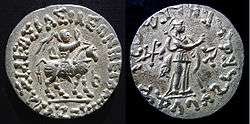
- Obv: King with coat of mail, on horse, holding a scepter, with Greek royal headband. Greek legend ΒΑΣΙΛΕΩΣ ΒΑΣΙΛΕΩΝ ΜΕΓΑΛΟΥ ΑΖΟΥ "The Great King of Kings Azes".
- Rev: Athena with shield and lance, making a hand gesture identical to the Buddhist vitarka mudra. Kharoshti legend MAHARAJASA RAJADIRAJASA MAHATASA AYASA "The Great King of Kings Azes", with the Buddhist triratna symbol in the left field.
Azes II was long believed to have issued several of the Indo-Scythian coins struck under the name Azes in northern India. All these coins were however likely issued by a single ruler named Azes, as suggested by Robert Senior, when he found an overstrike of a coin attributed to Azes I over a coin attributed to Azes II, suggesting that all the "Azes II" coins were not later than those of "Azes I" and that there was only one king in the dynasty named Azes.[2] This idea had long been advocated by Senior with a number of indirect numismatic arguments, for instance in his encyclopaedia of Scythian coins.[3]
Coin gallery
-

Portrait of Azes II
-
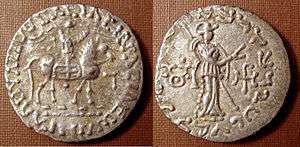
Coin of Azes II with Buddhist triratna symbol.
-

Coin of Azes II.
-
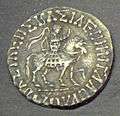
Coin of Azes II, with a clear depiction of his military outfit, with coat of mail and reflex bow in the saddle.
-
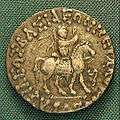
-
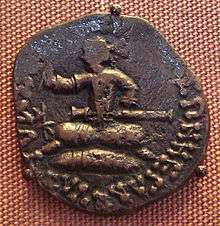
Coin of Azes II, with king seated, holding a drawn sword and a whip.
-

Seated king Azes II
-
Profile of king Azes II.
See also
- Ahir
- Ancient India and Central Asia
- Greco-Bactrian Kingdom
- Indo-Greek Kingdom
- Indo-Parthian Kingdom
- Kushan Empire
- Tillia tepe
- Yuezhi
External links
Footnotes
- ↑ Senior (2008), pp. 25-27.
- ↑ Senior, R. The final nail in the coffin of Azes II, and Azes: an unpublished an important tetradrachm S861T, Journal of the Oriental Numismatic Society 197, 2008
- ↑ Senior, R. Indo-Scythian Coins and History, (4 volumes), CNGcoins, London,England and Lancaster, Pennsylvania
References
- Senior, R. C. (2008). "The Final Nail in the Coffin of Azes II." Journal of the Oriental Numismatic Society 197 (2008), pp. 25–27.
- The Shape of Ancient Thought. Comparative studies in Greek and Indian Philosophies by Thomas McEvilley (Allworth Press and the School of Visual Arts, 2002) ISBN 1-58115-203-5
- The Greeks in Bactria and India, W. W. Tarn, Cambridge University Press.
| Preceded by: Azilises |
Indo-Scythian Ruler (35–12 BCE) |
Succeeded by: In Kashmir: Zeionises In Mathura: Kharahostes |